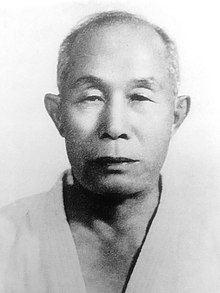
Back تشوى يونج سول ARZ Choi Yong-sul German Choi Young-sool Spanish چوئی یونگ سول Persian Choi Yong-sul French 최용술 Korean Choi Yong-sul Dutch Choi Yong-sul NB Чхве Ён Суль Russian Choi Yong-sool Vietnamese
| Choi Yong-sool | |
|---|---|
 Choi Yong-sool, circa 1954 | |
| Born | 9 November 1904 Chūseihoku-dō, Korea, Empire of Japan |
| Died | 15 June 1986 (aged 81) |
| Native name | 최용술/崔龍述 |
| Other names | Choi Yong-Sul, Yoshida Asao, Yoshida Tatujutsu |
| Residence | Daegu |
| Nationality | |
| Style | Daitō-ryū Aiki-jūjutsu, Hapkido |
| Trainer | Takeda Sōkaku |
| Rank | Doju, Grandmaster |
| Occupation | Martial artist |
| Notable students | Kim Yoon-sang Ji Han-jae Kim Moo-Hong Kim Yun-sik |
| Notable school(s) | Daehan Hapki YuKwonSool Dojang |
| [1][2][3][4] Last updated on: 2010-02-23 | |
| Choi Yong-sool | |
| Hangul | 최용술 |
|---|---|
| Hanja | |
| Revised Romanization | Choi Yong-sul |
| McCune–Reischauer | Ch'oe Yongsul |
Choi Yong-sool (Korean: 최용술; Hanja: 崔龍述; November 9, 1904 – June 15, 1986), alternative spelling Choi Yong-sul, was the founder of the martial art Hapkido (합기도; 合氣道). He was born in today's North Chungcheong Province, South Korea and was taken to Japan during the Japanese occupation of Korea when he was eight years old. Choi later stated that he became a student of Takeda Sōkaku, and studied a form of jujutsu known as Daitō-ryū Aiki-jūjutsu (大東流合気柔術) while in Japan.[5] Choi returned to Korea after the end of World War II and in 1948 began teaching his art at a brewery owned by the father of his first student Seo Bok-seob (서복섭; Suh Bok-sub). He first called his art "Yu Sul (유술)" or "Yawara (야와라; 柔術)" later changing it to "Yu Kwon Sool (유권술; 柔拳術)" and "Hap Ki Yu Kwon Sool (합기 유권술; 合氣柔拳術)" and eventually Hapkido.[6]
Choi Yong-sool was honored with the titles doju (도주; 道主), which can be translated as "Keeper of the way", and changsija (창시자; 創始者), which simply means "founder".[7] The arts of Hapkido, modern Hwa Rang Do, Kuk Sool Won, as well as lesser known arts such as Han Pul all show influence of the teachings of Master Choi.[8]
- ^ "합기도 ①" Archived 2015-03-23 at the Wayback Machine at Doosan EnCyber & EnCyber.com (두산 백과사전) (in Korean)
- ^ "합기도 ②" Archived 2015-03-23 at the Wayback Machine at Doosan EnCyber & EnCyber.com (두산 백과사전) (in Korean)
- ^ "합기도 ③" Archived 2015-03-23 at the Wayback Machine at Doosan EnCyber & EnCyber.com (두산 백과사전) (in Korean)
- ^ "합기도 ④" Archived 2015-03-23 at the Wayback Machine at Doosan EnCyber & EnCyber.com (두산 백과사전) (in Korean)
- ^ 허인욱의 무인이야기 장보고와 정년 그리고 송징 (in Korean)
- ^ Hentz, Eric (editor), Taekwondo Times Vol. 16, No. 8. Tri-Mount Publications, Iowa 1996. "The Beginning of Hapkido; An Interview with Hapkido Master Seo, Bok-seob" by Mike Wollmershauser.
- ^ "Untitled Document". hapkiyusul.com. Archived from the original on February 7, 2016.
- ^ Kim, He-young. Hapkido (alternately The Hapkido Bible). Andrew Jackson Press, Baton Rouge, Louisiana 1991.